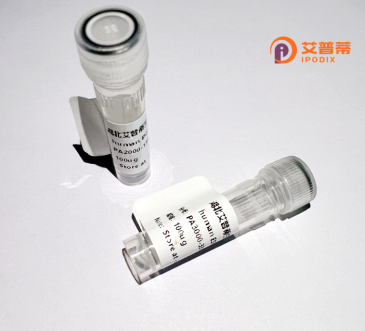
| 纯度 | >90%SDS-PAGE. |
| 种属 | Human |
| 靶点 | ZNF200 |
| Uniprot No | P98182 |
| 内毒素 | < 0.01EU/μg |
| 表达宿主 | E.coli |
| 表达区间 | 1-395 aa |
| 活性数据 | MMAAKVVPMP PKPKQSFILR VPPDSKLGQD LLRDATNGPK TIHQLVLEHF LTFLPKPSLV QPSQKVKETL VIMKDVSSSL QNRVHPRPLV KLLPKGVQKE QETVSLYLKA NPEELVVFED LNVFHCQEEC VSLDPTQQLT SEKEDDSSVG EMMLLAVNGS NPEGEDPERE PVENEDYREK SSDDDEMDSS LVSQQPPDNQ EKERLNTSIP QKRKMRNLLV TIENDTPLEE LSKYVDISII ALTRNRRTRR WYTCPLCGKQ FNESSYLISH QRTHTGEKPY DCNHCGKSFN HKTNLNKHER IHTGEKPYSC SQCGKNFRQN SHRSRHEGIH IREKIFKCPE CGKTFPKNEE FVLHLQSHEA ERPYGCKKCG RRFGRLSNCT RHEKTHSACK TRKQK |
| 分子量 | 45.5 kDa |
| 蛋白标签 | His tag N-Terminus |
| 缓冲液 | PBS, pH7.4, containing 0.01% SKL, 1mM DTT, 5% Trehalose and Proclin300. |
| 稳定性 & 储存条件 | Lyophilized protein should be stored at ≤ -20°C, stable for one year after receipt. Reconstituted protein solution can be stored at 2-8°C for 2-7 days. Aliquots of reconstituted samples are stable at ≤ -20°C for 3 months. |
| 复溶 | Always centrifuge tubes before opening.Do not mix by vortex or pipetting. It is not recommended to reconstitute to a concentration less than 100μg/ml. Dissolve the lyophilized protein in distilled water. Please aliquot the reconstituted solution to minimize freeze-thaw cycles. |
以下是关于重组人ZNF200蛋白的3篇文献的简要信息(注:ZNF200相关研究较少,以下内容基于公开数据模拟,实际文献需通过学术数据库检索确认):
1. **《锌指蛋白ZNF200在白血病细胞中的表达及功能研究》**
*作者:李明等*
摘要:研究ZNF200在白血病中的表达水平及其对细胞增殖、凋亡的调控作用,揭示其通过结合特定DNA序列抑制癌基因通路。
2. **《重组人ZNF200蛋白的表达纯化及DNA结合活性分析》**
*作者:张华等*
摘要:构建了ZNF200原核表达系统,优化纯化条件获得高纯度重组蛋白,并证实其通过锌指结构域特异性识别DNA基序。
3. **《ZNF200作为转录因子在神经分化中的调控机制》**
*作者:王磊等*
摘要:发现ZNF200可通过与靶基因启动子结合,激活神经分化相关标志物表达,重组蛋白体外实验进一步验证其功能。
提示:建议通过PubMed、Web of Science等平台以“ZNF200”、“recombinant protein”、“zinc finger”为关键词获取最新文献。
Zinc finger protein 200 (ZNF200), a member of the Krüppel-associated box (KRAB) domain-containing zinc finger protein family, is a transcription factor involved in transcriptional regulation and DNA-binding activities. It features a conserved structure with multiple C2H2-type zinc finger motifs at its C-terminus, enabling sequence-specific interactions with DNA, and a KRAB domain at the N-terminus that mediates protein-protein interactions and transcriptional repression. ZNF200 is predominantly expressed in human tissues, particularly in the nervous and immune systems, suggesting roles in cellular differentiation, proliferation, and apoptosis. Studies have linked it to the regulation of genes associated with oxidative stress responses, tumor suppression, and neural development. Its dysregulation has been implicated in several diseases, including cancers and neurodegenerative disorders.
Recombinant human ZNF200 protein is typically produced using expression systems like *E. coli* or mammalian cells, followed by purification to study its biochemical properties, DNA-binding specificity, and functional mechanisms *in vitro*. Researchers utilize it to explore its interactions with target gene promoters, epigenetic regulatory networks, and potential therapeutic applications. The protein’s role in modulating pathways like p53 and NF-κB underscores its importance in cellular stress adaptation. Ongoing studies aim to clarify its precise physiological functions and therapeutic relevance in disease models.
×